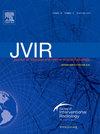Prostatic Artery Embolization: Mid- to Long-Term Outcomes in 1,075 Patients
IF 2.6
3区 医学
Q2 PERIPHERAL VASCULAR DISEASE
Journal of Vascular and Interventional Radiology
Pub Date : 2024-11-10
DOI:10.1016/j.jvir.2024.11.002
引用次数: 0
Abstract
Purpose
To assess the mid- to long-term safety and effectiveness of prostatic artery embolization (PAE) at a single-center cohort of 1,075 patients.
Materials and Methods
This institutional review board–approved retrospective study included patients with moderate-to-severe lower urinary tract symptoms (LUTS) or urinary retention who underwent PAE from January 2014 to July 2023. Patients were assessed at 1, 3, 6, and 12 months after PAE and yearly thereafter. The International Prostate Symptom Score (IPSS), quality of life (QoL) score, International Index of Erectile Function-5 (IIEF-5) score, prostate-specific antigen (PSA), prostate volume (PV), postvoid residual, benign prostatic obstruction (BPO) medication usage, urinary catheter status, and further prostatic interventions were assessed. Adverse events were recorded and classified using the Society of Interventional Radiology (SIR) adverse events (AEs) severity classification.
Results
The mean follow-up was 458.4 days (SD ± 559.5). The mean age was 70.4 years (SD ± 9.0), the median (interquartile range) PV was 107 g (76–150 g), and the median preprocedural IPSS, QoL, and IIEF-5 scores and PSA level were 23 (18–28), 5 (4–6), 17 (10–21), and 4.7 ng/mL (2.6–8), respectively. In the LUTS subgroup, at 1–3, 6–12, and 48–60 months, the median IPSS values were 7 (4–12, P < .001), 6 (3–11, P < .001), and 9 (4–15, P < .001), respectively. The QoL scores at the same time points were 2 (1–2, P < .001), 1 (0–2, P < .001), 2 (0–3, P < .001), respectively. Of 126 patients in the retention cohort, 119 (94%) were catheter-free at the 3-month follow-up. Ninety-patients (16% of reintervention eligible patients) required a second prostatic intervention up to 60 months after PAE. After PAE, 65.5% of patients were BPO medication–free at 1 year. Seven patients (0.65%) had severe AEs according to the SIR AE severity classification: (a) transient ischemic attacks, 3; (b) urosepsis, 2 (treated in the inpatient setting with intravenous antibiotics); and (c) prostate sloughing, 2 (needing transurethral resection of the prostate). All AEs resolved without permanent sequelae.
Conclusions
In a large cohort with long-term longitudinal follow-up, PAE showed significant, sustained long-term relief of LUTS, improved QoL, low reintervention rate, and high BPO medication–free rates. Ninety-four percent of catheter-dependent patients at baseline were catheter-free at 3 months.

前列腺动脉栓塞术 - 1075 例患者的中长期疗效。
背景:评估前列腺动脉栓塞术(PAE)的中长期安全性和有效性:目的:评估单中心 1075 例前列腺动脉栓塞术(PAE)的中长期安全性和有效性:这项经 IRB 批准的回顾性研究纳入了 2014 年 1 月至 2023 年 7 月期间接受 PAE 的中重度下尿路症状(LUTS)或尿潴留患者。患者在 PAE 术后 1、3、6 和 12 个月接受评估,此后每年接受一次评估。评估内容包括国际前列腺症状评分(IPSS)、生活质量评分(QoL)、国际勃起功能指数-5评分(IIEF-5)、前列腺特异性抗原(PSA)、前列腺体积(PV)、排尿后残余尿量(PVR)、良性前列腺梗阻(BPO)用药情况、导尿管状态以及其他前列腺干预措施。对不良事件进行记录,并采用介入放射学不良事件(SIR-AE)严重程度分类法进行分类:平均随访时间为 458.4±559.5 天。平均年龄(70.4±9.0)岁,前列腺体积中位数(IQR)为107gm(76-150),术前IPSS、QoL、IIEF-5和PSA的中位数分别为23(18-28)、5(4-6)、17(10-21)和4.7(2.6-8)。在 LUTS 亚组中,1-3、6-12 和 48-60 个月的 IPSS 中位数分别为 7(4-12,p):在一个长期纵向随访的大型队列中,PAE能显著、持续地长期缓解LUTS,改善QoL,降低再次干预率,提高无BPO药物治疗率。94%的基线导管依赖患者在3个月后不再使用导管。
本文章由计算机程序翻译,如有差异,请以英文原文为准。
求助全文
约1分钟内获得全文
求助全文
来源期刊
CiteScore
4.30
自引率
10.30%
发文量
942
审稿时长
90 days
期刊介绍:
JVIR, published continuously since 1990, is an international, monthly peer-reviewed interventional radiology journal. As the official journal of the Society of Interventional Radiology, JVIR is the peer-reviewed journal of choice for interventional radiologists, radiologists, cardiologists, vascular surgeons, neurosurgeons, and other clinicians who seek current and reliable information on every aspect of vascular and interventional radiology. Each issue of JVIR covers critical and cutting-edge medical minimally invasive, clinical, basic research, radiological, pathological, and socioeconomic issues of importance to the field.

 求助内容:
求助内容: 应助结果提醒方式:
应助结果提醒方式:


